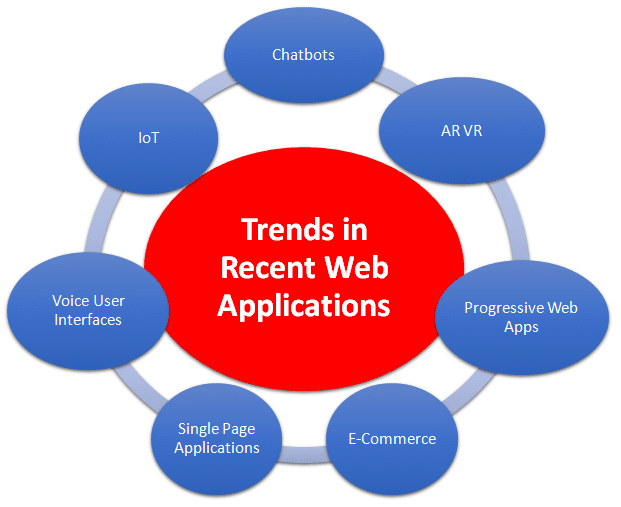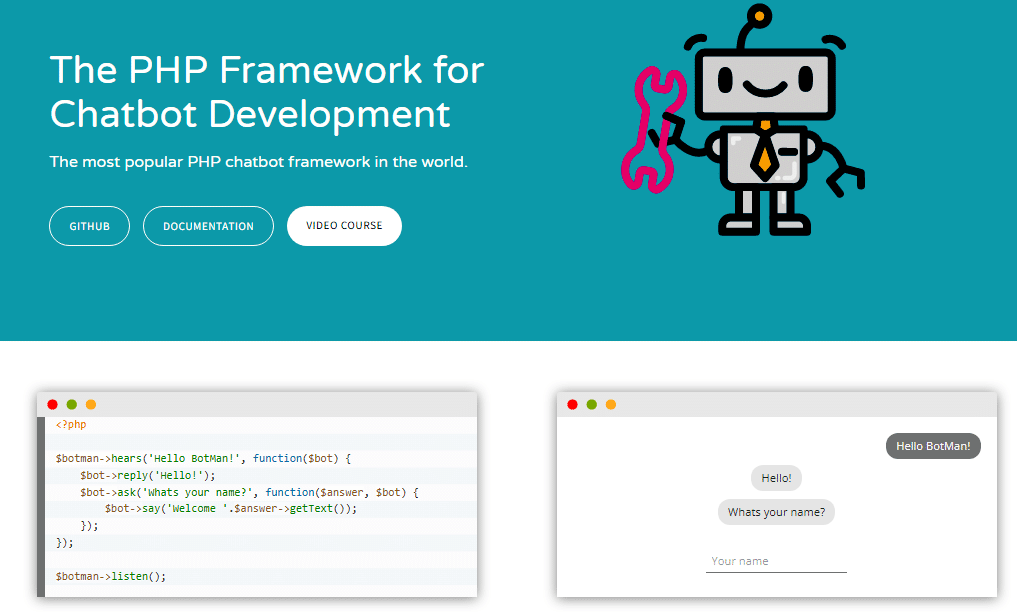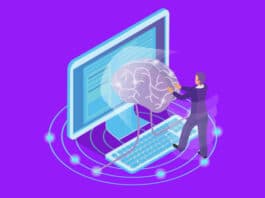From customer support to personalised recommendations, chatbots are reshaping the way businesses engage with their users. Here we explore free and open source frameworks and databases for web-based chatbot development, empowering readers to create interactive conversational experiences.
Web applications have become an essential component of our digital existence, serving a diverse range of purposes in various sectors. One prevalent application is in the field of e-commerce, where these web-based platforms enable businesses to sell their products and services online. They efficiently manage tasks such as maintaining product catalogues, ensuring secure payment processing, and offering personalised recommendations. Another significant application is seen in communication and collaboration tools, which empower teams to work together seamlessly irrespective of their physical locations. Such web applications facilitate real-time messaging, file sharing, and project management, enhancing productivity.
Moreover, web applications have made significant contributions to the education and e-learning domain by providing platforms for online courses, virtual classrooms, and interactive learning materials. They offer students and educators the convenience of accessing educational resources anytime and from anywhere. Additionally, in the healthcare industry, web applications are instrumental in delivering telemedicine services. They enable remote consultations, facilitate appointment scheduling, and ensure the secure sharing of medical records, improving healthcare accessibility and convenience.
Web applications have also found significant utility in the realm of finance and banking. They empower users to efficiently manage their accounts, perform transactions, and securely access financial information. These applications offer features such as real-time monitoring of account balances, seamless fund transfers, and effective management of investment portfolios. In the travel and hospitality sector, web applications provide online booking systems for flights, hotels, and car rentals, streamlining the reservation process and enhancing customer convenience.
Furthermore, web applications serve as indispensable tools in social media platforms, offering users the means to connect, share content, and engage with others. These applications provide a wide range of features including user profiles, news feeds, messaging capabilities, and multimedia sharing functionalities. Additionally, web applications are extensively employed in data analytics and visualisation, enabling businesses to collect, process, and present data in a meaningful manner through interactive dashboards and charts. This facilitates informed decision-making and generation of valuable insights.
From e-commerce to education, communication to finance, web applications continue to advance and revolutionise various industries, offering innovative solutions and enriching user experiences in the digital era.

Recent trends and use cases of web applications
Chatbots and virtual assistants with artificial intelligence (AI) integration: Web applications are being enhanced with the integration of AI technologies such as machine learning and natural language processing. This integration enables the incorporation of advanced features like chatbots, recommendation systems, and personalised content delivery. By leveraging AI, web applications can deliver more precise and customised user experiences.
Progressive web applications (PWAs): In recent years, PWAs (progressive web applications) have gained substantial attention and popularity. These web-based applications offer users an experience similar to native apps, right within their web browser. PWAs come with several benefits, including offline functionality, push notifications, and quicker loading times. They eliminate the requirement for users to download and install traditional mobile apps while ensuring a smooth and seamless user experience.
Voice user interfaces (VUIs): The emergence of voice assistants such as Amazon Alexa and Google Assistant has led to the integration of voice user interfaces (VUIs) into web applications. VUIs allow users to interact with web applications through voice commands. This functionality proves particularly valuable for hands-free interactions, making it well-suited for smart speakers, voice-enabled devices, and even in-car applications.
Internet of Things (IoT) connectivity: The utilisation of web applications for controlling and interacting with IoT devices is on the rise. IoT-enabled web applications have the capability to communicate with various devices including smart home appliances, wearables, and industrial sensors. These applications serve as a centralised interface through which users can remotely monitor and control their IoT devices.
Augmented reality (AR) and virtual reality (VR): Web applications are integrating AR (augmented reality) and VR (virtual reality) technologies to deliver captivating and immersive experiences. AR-enhanced web applications superimpose digital information onto the real world, enriching the user’s perception and interaction with their surroundings. On the other hand, VR-enabled web applications create virtual environments, transporting users to entirely new immersive worlds. These technologies are being applied across diverse industries such as gaming, e-commerce, real estate, and training simulations, revolutionising the way users engage with digital content.
Single-page applications (SPAs): SPAs have gained popularity due to their responsive and interactive nature. SPAs load the entire application on a single web page, reducing the need for frequent page reloads. This results in a smoother user experience, faster navigation, and improved performance. SPAs are commonly used for social media platforms, project management tools, and real-time collaboration applications.
E-commerce and online marketplaces: The expansion of e-commerce has given rise to the emergence of web applications that cater specifically to online retail and marketplaces. These applications serve as platforms for seamless online transactions, efficient product catalogue management, secure payment processing, and personalised recommendations. Additionally, they incorporate functionalities such as inventory management, order tracking, and customer support systems to ensure a comprehensive and satisfying shopping experience for users.
Collaborative tools and productivity suites: Web applications are being used to enhance collaboration and productivity in various domains. Applications like project management tools, document collaboration platforms, and video conferencing systems enable remote teams to work together efficiently. These tools often incorporate real-time editing, task assignment, file sharing, and communication features.
Data analytics and visualisation: Web applications play a vital role in analysing and presenting data in a user-friendly and comprehensible manner. These applications collect, process, and visualise data, enabling users to gain insights and make informed decisions. They find widespread application in areas such as business intelligence, data science, and reporting, offering users the ability to explore data through interactive dashboards and charts, thereby facilitating a deeper understanding of the information at hand.
Personalisation and customisation: Web applications are placing a growing emphasis on delivering personalised experiences to users. Through the utilisation of user data, preferences, and behaviour patterns, these applications offer customised content, recommendations, and user interfaces. Personalisation plays a crucial role in enhancing user engagement, satisfaction, and ultimately, conversion rates.
Integration aspects of chatbots and virtual assistants in web applications
Chatbots and virtual assistants have emerged as game-changing tools in today’s digital landscape, transforming the way businesses engage with their customers and users. These intelligent conversational agents deliver personalised and automated experiences, offering a wide array of benefits across various industries.
Chatbots, which simulate human conversation, are typically integrated into web applications, messaging platforms, and mobile apps. They enable businesses to automate customer support, address frequently asked questions, and provide real-time assistance. By leveraging natural language processing (NLP), chatbots understand user queries and generate relevant responses. With the ability to handle multiple conversations simultaneously, they enhance response times and elevate customer satisfaction.
Virtual assistants, on the other hand, go a step further by harnessing the power of artificial intelligence (AI). These advanced chatbots, including popular examples like Amazon Alexa, Google Assistant, and Apple’s Siri, comprehend voice commands, execute tasks, and retrieve information from diverse sources. Virtual assistants excel at helping users with tasks such as setting reminders, playing music, checking the weather, and controlling smart home devices.
Businesses across industries are embracing chatbots and virtual assistants to enrich customer service, streamline operations, and elevate user experiences. In e-commerce, chatbots guide users through the purchasing journey, offer product recommendations, and deliver instant support. In banking and finance, virtual assistants assist customers with balance enquiries transaction history, and bill payments. In healthcare, chatbots triage patient enquiries provide basic medical information, and facilitate appointment scheduling.
Chatbots and virtual assistants prove valuable for data collection and analysis. They gather user preferences, behaviour patterns, and feedback, providing businesses with insights into customer needs and preferences. This data fuels personalised user experiences, improves product offerings, and enhances marketing strategies.
As technology advances, chatbots and virtual assistants evolve with more sophisticated capabilities. They incorporate machine learning algorithms to enhance their understanding of user intent and context, resulting in more accurate and contextually relevant responses. Integration with technologies such as natural language generation, sentiment analysis, and image recognition further expands their functionalities.
Chatbots and virtual assistants offer personalised and efficient interactions, automate tasks, and provide round-the-clock support. With ongoing advancements in AI and NLP, these conversational agents are poised to play an increasingly influential role in shaping customer experiences and driving business success.

BotMan, the free and open source framework for web based chatbots and virtual assistants
BotMan (https://botman.io/) is a PHP chatbot framework that is freely available and open source. It streamlines the process of developing chatbots for various messaging platforms like Facebook Messenger, Slack, and Telegram. With its fluent and expressive API, BotMan offers developers a straightforward and effective approach to building conversational experiences. It empowers developers by providing a convenient and efficient means to create and deploy chatbot applications across multiple messaging platforms. The BotMan framework is renowned for its extensive feature set and versatile functionalities, making it a favoured option among developers.
The framework seamlessly integrates with popular natural language processing (NLP) services like Dialogflow, Wit.ai, and IBM Watson. This integration empowers developers to incorporate advanced natural language understanding capabilities into their chatbot applications, resulting in more sophisticated and context-aware conversations.
BotMan provides efficient tools for managing the flow of conversations within chatbot applications. Developers can define conversational workflows, handle user inputs, and create interactive dialogues using features like middleware and conversation drivers. This enables the design of dynamic and engaging chatbot experiences.
Simplifying the process of intent recognition and entity extraction, BotMan facilitates the identification of user intents and the extraction of relevant information from user messages. It offers convenient methods for defining intents and entities, enabling developers to build chatbots capable of accurately understanding and responding to user queries.
The framework also includes built-in support for user storage and context management. This functionality allows developers to store and retrieve user-specific data during conversations, facilitating personalised and context-aware interactions. Chatbots built with BotMan can remember user preferences and deliver tailored responses accordingly.
With BotMan, developers can leverage rich message and attachment support to enhance chatbot conversations. They can send various types of content such as images, videos, buttons, and quick replies to users, resulting in visually appealing and interactive chatbot experiences.
BotMan offers extensive extensibility and customisation options. It provides a robust plugin system and a rich set of APIs, allowing developers to add custom features and functionalities as per their specific requirements.
The BotMan framework finds applications in a wide range of domains. It can be used to build customer support chatbots, virtual assistants, e-commerce chatbots, information retrieval bots, and more. Its flexibility and multi-platform support make it suitable for creating chatbot applications that cater to different industries and use cases.
Other frameworks for chatbot development
There are other options available for chatbot development too. Let’s check out the most popular of these choices.
Rasa
Rasa is an open source framework for building chatbots and virtual assistants. It provides tools and libraries for natural language understanding (NLU) and dialogue management. Rasa offers a developer-friendly environment and supports integration with various messaging platforms. The Rasa website offers extensive documentation, tutorials, and community support to get started with building chatbots.
Botpress
Botpress is a chatbot development platform that facilitates the creation, deployment, and management of chatbots. As an open source solution, it offers users the flexibility to customise and extend its capabilities. With its intuitive visual interface, Botpress simplifies the process of building conversational flows, enabling users to design interactive chatbot experiences effectively. The platform also integrates natural language understanding (NLU) capabilities, enhancing the chatbot’s ability to comprehend user inputs. Furthermore, Botpress provides seamless integration with popular messaging channels, allowing chatbots to engage with users across various platforms. To support users, Botpress offers a wealth of resources, comprehensive documentation, and an active community forum for assistance and collaboration.
ChatterBot
https://github.com/gunthercox/ChatterBot
ChatterBot is a Python library that enables you to create chatbots with natural language processing capabilities. It includes pre-trained language models and allows you to train your own models for custom chatbot behaviour. The GitHub repository provides documentation, examples, and code samples.
Dialogflow
https://cloud.google.com/dialogflow
Dialogflow, associated with Google, is a platform for natural language understanding that empowers users to create conversational agents. It provides a range of plans, including both free and paid options, catering to different requirements. Dialogflow facilitates integration with a multitude of messaging platforms and voice assistants, ensuring compatibility and versatility in deployment. By leveraging Dialogflow, users can build powerful conversational agents that enable seamless interactions across different channels and voice-enabled devices.
Scope of research and development
The field of research and development in web application development with chatbots and virtual assistants holds immense potential and promising opportunities. As these technologies progress, several areas emerge for exploration and innovation. One such area is the enhancement of chatbots and virtual assistants’ ability to comprehend and interpret human language. Ongoing research in natural language processing (NLP) algorithms and models can lead to more precise and context-aware responses, better understanding of user intentions, and smoother conversational experiences. Continued research in domains like NLP, context awareness, multimodal interaction, personalisation, advanced AI techniques, security, privacy, and ethics will be instrumental in driving innovation and shaping the future of these technologies. By delving into these avenues, researchers can uncover novel possibilities for creating web applications that are more intelligent, interactive, and user-centric. These advancements can pave the way for a new generation of web applications that deliver enhanced user experiences and cater to a wide range of needs.




